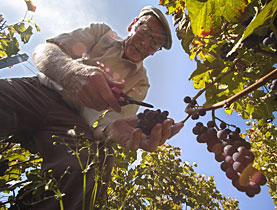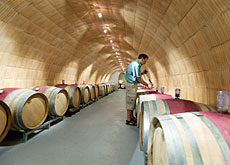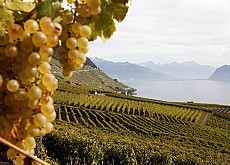Wine makers raise glasses to a good vintage

This year's stable weather conditions should lead to an excellent, healthy grape crop, wine producers in western Switzerland are predicting.
Vineyards in French-speaking areas – where most Swiss wine is grown – are due to start gathering grapes from Wednesday.
Over the past two weeks, cool evenings and sunny days have encouraged the conservation of aromas and helped the grapes ripen well. They have also prevented the possible development of fungal diseases such as grey mould.
Wine makers are hoping that similar conditions will prevail during the harvesting period, and the gods seem to be on their side as no rain is forecast over the coming days.
“The vines are in a very healthy condition. 2008 looks like it’ll be a good vintage,” said Michel Pont, scientific advisor with canton Valais’s winegrowing department.
“It’s not as good as 2007; it’s maybe something like 2006, which was a good vintage, but not the best we’ve seen these past ten years,” Thierry Walz, director with Cave la Côte and a member of the Swiss Wine Exporters’ Association, told swissinfo.
The southern canton Valais is the main wine-producing region of Switzerland with vines covering 5,136 hectares. Vaud – the area around Lausanne – is in second place with grapes over 3,851 hectares, followed by Geneva with 1,288 hectares.
Wine is also produced to a lesser extent in Ticino (1,036 hectares), around Zurich (619 ha), Neuchâtel (596 ha) and Schaffhausen (472 ha).
Regions and varieties
The quantity of grapes harvested in French-speaking regions should be slightly up on last year. According to the Valais winegrowers’ association, three per cent more should be gathered in the canton, all grape varieties included.
Certain grape varieties are expected to do better than others, explained Walz.
“The Chasselas grape should be good this year and the Pinot Noir is looking really exceptional. The Gamay grape will have an average year and Chardonnay and Gamaret will be quite good,” he said.
In canton Vaud winemakers are announcing a healthy, golden harvest compared with 2007.
“Looking at the whole canton, we are expecting to produce about 23.5 million litres of white wine and 8.5 million litres of red wine,” explained Gilles Cornut, president of the Community of Vaud Wine Producers.
In Geneva picking the grapes for local sparkling wines started back in mid September, but the main crop should be harvested from October 8, said cantonal wine expert Alexandre de Montmollin.
In canton Neuchâtel the first pruning shears will be brought out on October 6.
“The harvest looks fine and should result in a good vintage,” said Sébastien Cartillier, head of the cantonal wine-growing department.
The vines that were partly affected by hailstones this summer have recovered well.
“If we don’t get any mould, the total yield for the whole canton, all grape varieties included, should get close to the norm – 750 grams per square metre,” he said, compared with 630g/m2 in 2007.
Tough profile
After a drop in consumption over the past few years, the Swiss have begun drinking more wine again.
In 2007, 280 million litres of red, white and rosé were downed by drinkers, up 3.6 per cent over the previous year.
Foreign wines, mainly those from France, Italy and Spain, are still favoured over local production. But indigenous wines sales grew by 5.7 per cent last year, representing some 108 million litres.
This is one of the reasons you don’t see many Swiss wines outside Switzerland, say experts.
“There is currently not enough Swiss wine to meet demand,” said Walz. “We had small harvests so there is limited availability; we can hardly meet the demand in Switzerland which discourages a little bit those who want to export.”
But the main reason why Swiss wine is absent from foreign supermarket shelves and restaurant tables is that there is only a small wine-growing area in Switzerland – 15,000 hectares – the same size as Alsace in France, he added.
“But Alsace has two grape varieties, while we have more than 40. Our production is very small and when we export we have difficulties finding the niche markets,” said the exporter, adding that small volumes also mean high transport costs and taxes.
And if Swiss winemakers want to produce larger volumes, they often don’t have the critical mass, said Walz.
“If we speak to Coop supermarket in Switzerland we negotiate orders of around 120,000-150,000 bottles, but if we talk to the Carrefour supermarket in France or with Waitrose in Britain they want to order between 500,000 and one million bottles. It’s just not possible with one single Swiss wine,” he said.
swissinfo with agencies
Switzerland’s winegrowing regions can be subdivided into six areas: Valais, Vaud, Geneva, the Three Lakes region in western Switzerland, the German-speaking region of eastern Switzerland, and the Italian-speaking Ticino.
The most typical white grape variety is Chasselas, whose extreme sensitivity to both soil and situation is reflected in subtle differences in taste.
Among the red grape varieties, the most widespread is Pinot Noir, which can take very different characters depending on the region from where it comes and the type of vinification it has undergone.
The Swiss drank just over 280 million litres of wine last year, up 3.6 per cent on 2006.

In compliance with the JTI standards
More: SWI swissinfo.ch certified by the Journalism Trust Initiative


You can find an overview of ongoing debates with our journalists here. Please join us!
If you want to start a conversation about a topic raised in this article or want to report factual errors, email us at english@swissinfo.ch.